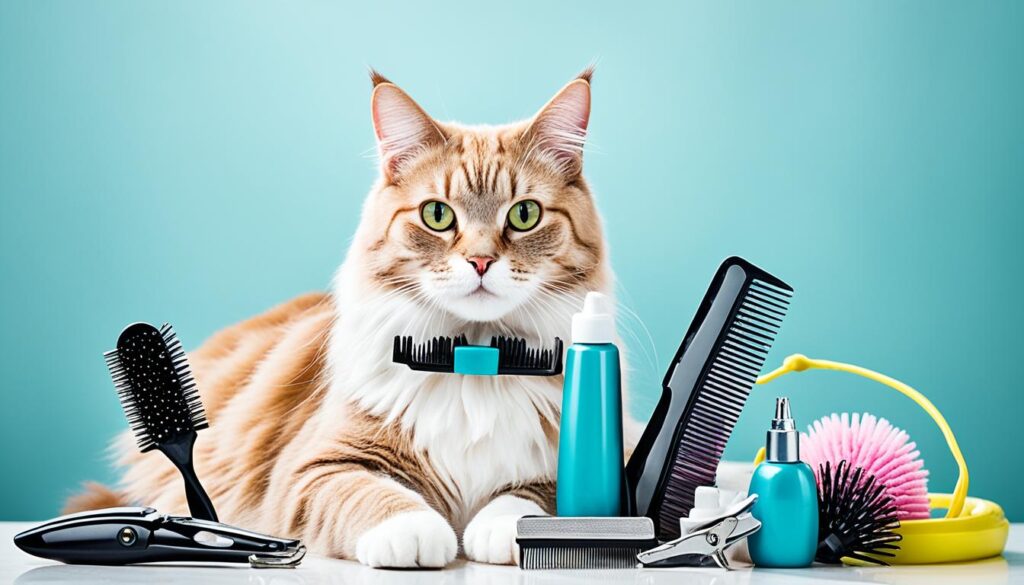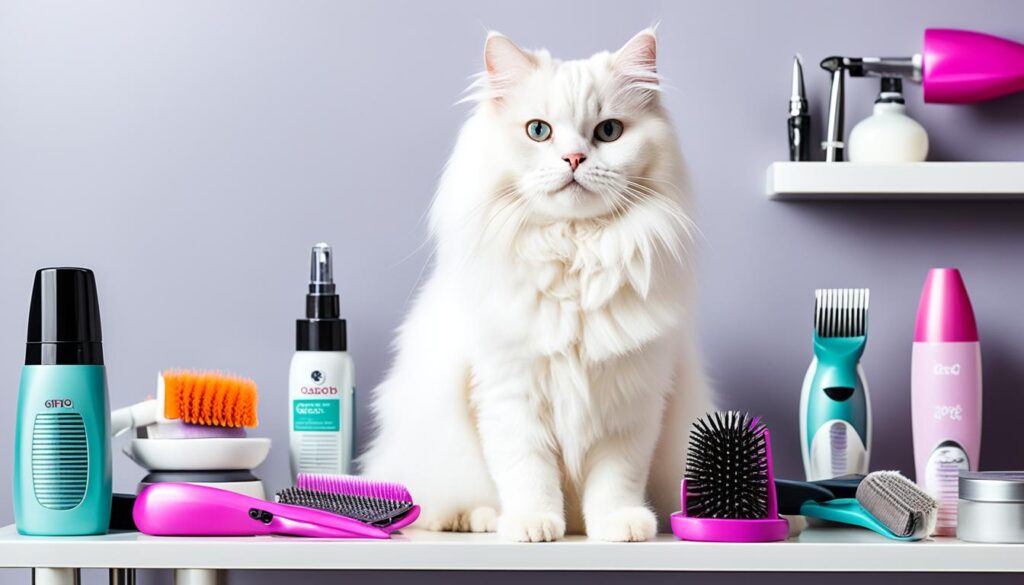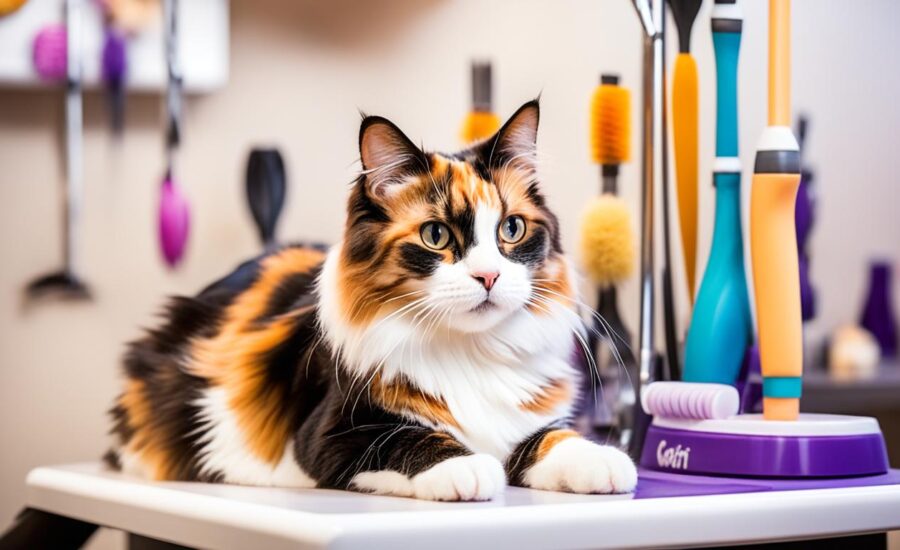Cat Grooming 101 is not just about looks. It’s a way to ensure your cat stays happy and healthy. By choosing to groom your cat at home, you dive deeper into what your pet truly needs.
It becomes a valuable time for bonding. It also lets you see your cat’s needs that many miss. With the right cat care advice, grooming at home is not just a duty. It’s a chance to make your relationship with your cat stronger.
Key Takeaways
- Realize that cat grooming significantly impacts overall health beyond just appearance.
- Discover how to begin grooming routines early for feline familiarity and acceptance.
- Learn why regular grooming routines can strengthen your bond with your cat.
- Gain insight on selecting appropriate grooming tools for a safe and pleasant experience.
- Understand the importance of patience and positive reinforcement in grooming sessions.
Understanding the Importance of Cat Grooming
Grooming is vital for your cat’s health, not just for looks. It goes beyond making them appear clean. Following the right feline grooming tips enhances their coat and avoids many health problems. This improves your furry friend’s life significantly.
The Health Benefits Beyond a Shiny Coat
Regular grooming boosts natural oil production in your cat’s skin. These oils keep their coat shiny and healthy, much like healthy human hair. By using advanced cat grooming techniques, dead skin and loose fur are removed. This process fights against matting and keeps the coat smooth.
Preventing Parasites and Promoting Well-being
Grooming is crucial in fighting off parasites like fleas and ticks. These pests can make your cat very uncomfortable and cause diseases. By grooming your cat often, you can spot these parasites early. This stops them from spreading. Plus, regular cat hygiene tips help reduce hairballs. This makes your cat, and your home, cleaner and happier.
- Regular grooming identifies parasites early, preventing infestation
- Consistent brushing reduces shedding and hairballs
- A clean cat is a happier, more comfortable pet
Cat Grooming 101: Tips for Keeping Your Feline Friend Happy
Start teaching your cat about grooming tools for cats when they’re young. This will make grooming a positive experience for both of you. With the right cat grooming techniques, grooming becomes fun, not just a necessity. It’s all about making your cat feel loved and secure during these sessions.
Early Exposure: The Key to Grooming Success
Grooming should start early to get your cat used to it. Things like holding their paws and brushing them gently help a lot. Gradually, your cat will find grooming normal and not stressful. This makes using grooming tools for cats something they won’t fear.
Creating a Bond and Routine through Grooming
Routine is crucial for a happy cat. They love knowing what’s happening and when. Doing cat grooming techniques often helps them get used to it. Plus, it strengthens your bond. So, create a grooming schedule that works for your cat. It should match their needs and what they’re comfortable with.
| Grooming Tool | Type of Coat | Frequency of Use | Benefits |
|---|---|---|---|
| Soft Bristle Brush | Short Hair | Weekly | Promotes shine, removes loose fur |
| Wire Pin Brush | Medium to Long Hair | Bi-Weekly | Detangles without pulling |
| Grooming Glove | All Types | As Needed | Pleasant for the cat, easy to use |
| Mat Splitter | Long Hair, Prone to Matting | As Needed | Safely cuts through mats |
| Nail Clippers | All Types | Monthly | Keeps nails at healthy length |
Essential Cat Grooming Tools for At-Home Care
For your cat to look and feel its best, you’ll need certain cat grooming techniques and special grooming tools for cats. This guide highlights the best tools for a home grooming kit. It will help keep your cat’s coat beautiful and healthy.

Selecting the Right Brush for Your Cat
Choosing the right brush is key. It should match your cat’s coat type. Brushes remove tangles and loose fur. They also spread natural oils, which keeps the skin and coat in good shape.
Long-haired cats need brushes with longer teeth to handle mats. For short-haired cats, choose brushes with shorter bristles to smooth the coat and remove loose hair.
Additional Tools: Scissors, Nail Clippers, and Mats
Sometimes, you need to trim your cat’s coat, especially in places where mats form. Use rounded-tip scissors for safe trimming around delicate spots. It’s also vital to trim your cat’s nails to keep them happy and your furniture safe. So, you’ll need a durable pair of nail clippers.
A mat splitter is also a must-have for tough mats that brushes can’t fix.
| Grooming Tool | Description | Best Use |
|---|---|---|
| Detangling Brush | Features a mix of longer and shorter teeth for ease of use. | Perfect for daily brushing to prevent mats and remove loose fur. |
| Rounded-tip Scissors | Safely trims fur around delicate areas without risking injury. | Recommended for areas prone to knotting, like behind the ears. |
| Nail Clippers | Sturdy clippers designed for a cat’s small and delicate claws. | Use them every few weeks to keep claws at a healthy length. |
| Mat Splitter | A specialized tool to slice through and remove tough mats. | Essential for long-haired cats or those with dense undercoats. |
Getting the right grooming tools for cats prepares you for safe and effective cat grooming techniques. With these tools, you can keep your cat’s coat and nails in top shape. They ensure your pet stays looking great and feeling happy.
Simplifying the Detangling Process
Learning cat grooming techniques is crucial for grooming your cat at home. Detangling fur can be tough. A smooth, pain-free grooming needs the slow introduction of tools. Also, a careful method to unravel mats and knots is vital. Getting your cat used to brushing slowly helps make grooming calm.
Start with easy spots like the cat’s back, then move to sensitive areas. These include the belly or inside the legs. By carefully detangling from tip to base, you avoid pulling. This makes grooming more comfortable for your cat.

- Let your cat look at the brush first. This shows it’s safe.
- Begin with spots your cat likes being brushed, like the back and sides.
- For mats, choose a brush with varied teeth lengths. Gently work from ends to roots.
- Always brush the way the fur grows to keep it painless.
| Area to Groom | Brush Type | Technique |
|---|---|---|
| Back | Wide-toothed comb | Long strokes, with the grain |
| Sides | Pin brush | Gentle, circular motions |
| Belly | Soft slicker brush | Careful, short strokes |
| Legs | Detangling spray and comb | Minimum pressure, treat mats delicately |
Grooming your cat at home can be simple. The right approach and regular practice make all the difference. Your cat will start to see cat grooming techniques as relaxing. Remember, the secret is to be patient, handle gently, and use the correct tools.
Nail Trimming: A Step-by-Step Guide
Keeping your cat’s nails trimmed is key to their health and prevents scratches. It’s more than making them look good; it’s a big part of keeping them and everyone around safe. Before getting into how to trim nails, it’s vital to get your cat used to being handled. Start by gently massaging their paws. This will get them ready for safe and proper nail cutting.
Getting Your Cat Comfortable with Paw Handling
To ease your cat into nail clipping, start with positive paw touching when they’re calm. Gently hold and rub their paws. Doing this regularly makes them okay with being touched and preps them for nail cutting. Also, check their paws for any issues during your grooming your cat at home routine.
Safe Claw Trimming Techniques
Once touching your cat’s paws is okay, introduce the correct nail trimmer. Use ones meant for cats to ensure a clean cut without splitting the nail. Cut the claws parallel to the flat part, avoiding the quick to prevent bleeding and pain. Below, find an easy table for safe claw trimming:
| Step | Description | Tip |
|---|---|---|
| 1 | Choose the Right Time | Pick a moment when your cat is calm, such as after eating or playing. |
| 2 | Position Your Cat | Have your cat sit in your lap or on a comfy surface they like. |
| 3 | Expose the Claws | Press the top and bottom of each paw to show the claws for trimming. |
| 4 | Trim Carefully | Cut the white part of the nail, avoid the pink quick with blood vessels and nerves. |
| 5 | Reward Your Cat | Give a treat or some love right after trimming to make it a positive experience. |
Trimming regularly and with care is vital in grooming your cat at home. With patience and practice, it’ll become an easy part of your care routine. Check out our next sections for more cat care advice.
How to Manage Cat Bath Time Efficiently
Bathing your feline friend is crucial but might not be easy. It’s a key part of grooming your cat at home. This is especially true for outdoor cats and breeds like the hairless Sphynx. They need baths to stay healthy and clean. Start by getting everything ready before the bath. You’ll need grooming gloves, cat-friendly shampoo, and a non-slippery mat. These items help your pet stay stable and comfy during their bath.
Preparing well leads to a smoother bath time. Remember, feline grooming tip: keep it short. Cats usually don’t like long baths. Use warm water to wet their coat. Then, carefully apply shampoo, avoiding the face and ears. Stay calm throughout, as cats can sense stress. This helps keep them relaxed too.
Finishing up quickly is as crucial as the washing part. Rinse your cat well then wrap them in a warm, fluffy towel. It’s important they dry off completely to stay comfy and healthy. With the right steps, bath time becomes easier. It’s part of grooming your cat at home. This helps strengthen the bond with your cat while keeping them clean and healthy.
How to Manage Cat Bath Time Efficiently
What are the health benefits of grooming beyond just a shiny coat?
How does regular grooming help prevent parasites and promote my cat’s well-being?
Why is early exposure important for successful cat grooming?
How can grooming help in creating a bond between me and my cat?
What type of brush is right for my cat?
What additional grooming tools should I consider?
How can I make the detangling process easier for my cat?
How can I get my cat comfortable with paw handling for nail trimming?
What’s the safest technique for trimming my cat’s claws?
How can I effectively manage my cat’s bath time?
Source Links
- https://www.kittyspout.com/blogs/blog/grooming-101-community-sourced-tips-for-your-beloved-feline
- https://us.tangleteezer.com/blogs/inspiration/cat-grooming-101-how-to-groom-your-cat
- https://villagegateveterinary.com/blog/cat-grooming-101/

